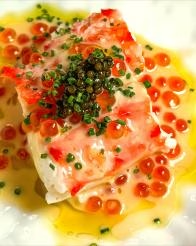Today, we’ll introduce you to a premium ingredient: authentic caviar.
What exactly is caviar?
Caviar refers to sturgeon eggs. “Authentic caviar” not only refers to sturgeon eggs, but also requires eggs from species of sturgeon native to the Caspian and Black Seas, which lie at the junction of Europe and Asia.
Roes from the Beluga, Ossetra, and Sevruga sturgeons are considered the highest quality, and their scarcity leads to their high price. In fact, today’s caviar isn’t sourced from wild sturgeons, as they are being overfished and their numbers are dwindling. The United Nations has long banned the trade and hunting of wild caviar, leading to the increasing popularity of farmed sturgeon caviar.
In the early days, wild caviar was most famous in countries like Russia and Iran, which surround the Caspian and Black Seas. However, with the adoption of farmed caviar, countries like the United States and France have also emerged as major players in the caviar market. American farmed caviar has been praised by celebrity chefs like Gordon Ramsay as being incredibly delicious, rivaling even the wild caviar of earlier generations.
Speaking of caviar, it’s worth noting that supermarkets in countries like the United States and Canada offer a wide variety of products labeled “Caviar.” Besides genuine sturgeon roe, eggs from other fish, such as salmon, are also considered caviar.
If you’re buying genuine caviar, be sure to carefully read the label to confirm whether it comes from sturgeon and which species it is. Don’t buy the wrong one.
How to Serve Caviar with Food
The best way to enjoy caviar is to use it raw as a garnish on food. This simple and unpretentious way is the most delicious. For example, a small amount of caviar can be added directly to seafood, salads, eggs, soups, steaks, pizza, crackers, and even American muffins.
The best wine to pair with caviar is a white wine that’s best paired with seafood dishes. Most caviar on the market is salted, so the salt content of the food can be reduced slightly. This depends on the salt content of the caviar you purchase. Generally, the higher the quality and fresher the caviar, the less salt is used during the salting process. The best caviar has a salt content of approximately 3% to 5%.
How to store Caviar
Precious caviar is very fragile, so it must be refrigerated before consumption, not at room temperature, to maintain its freshness. However, pasteurized and compressed caviar are exceptions. Pasteurized caviar can contain more than 5% salt.
While it can be stored for a long time and kept at room temperature before opening, the pasteurization process slightly heats it, affecting the texture and flavor of the caviar. It’s considered a lower-quality caviar, with pressed caviar being the lowest quality.
Compressed caviar is the mixture of roe from different sturgeons, often accidentally broken during packaging. This mixture is compressed into a paste-like paste, sometimes in chunks. It has a higher salt content, exceeding 8%, and can be stored longer than pasteurized caviar, but the flavor certainly won’t compare to fresh, granular caviar.


Leave a Reply